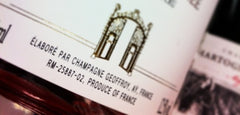The Wine Beagle guide to Christmas fizz
Sparkling wine of some sort is surely a Christmas essential. But where to start? There are so many different types, prices vary wildly and the question of what represents real value is often quite opaque.
In my view, step one is to avoid the sub £15 Champagnes. They really aren’t up to it. If you’re trying to keep the price down, you’re much better off with some Cava (made in the same way as Champagne but generally with different grapes), Prosecco (though not the really cheap, cloying stuff please!), or maybe a Crémant of some kind – these are the Champagne equivalents from other regions around France, again they’re made in the same way as Champagne, but the grapes used will be the speciality of that region. Crémant de Bourgogne is often a good bet, or Crémant de Loire.
If you’re happy to spend north of £20, I’d advocate the ‘Grower’ Champagnes. Unlike the big brands who buy in grapes from all over the region, ‘Grower’ Champagnes are made from grapes grown by the producers themselves. This means that they have control of the process from start to finish and can produce ‘terroir’ driven wines. I.e. wines that represent a particular place. Given that these are two central tenets of fine wine production the world over, I’m not quite sure how the big Champagne brands have persuaded us that the same shouldn’t apply there. In order to work out if a Champagne is in this category, you need to look for the letters RM on the bottle. This stands for Recoltant-Manipulant as seen below:

Keeping it more local, English fizz has very much come of age and quality is now up there with some of the better Champagnes. Prices however are still quite high, so although this can make an interesting choice, you’ll have to be prepared to pay at least £20 a bottle for a good one and, dare I say it, a Champagne at the same price would probably be better value.
For the more adventurous, look out for some German Sekt. Made from either Riesling or Pinot Noir, this dry sparkling wine can be absolutely delicious and there is excellent value to be found in the £15 - £20 bracket.
